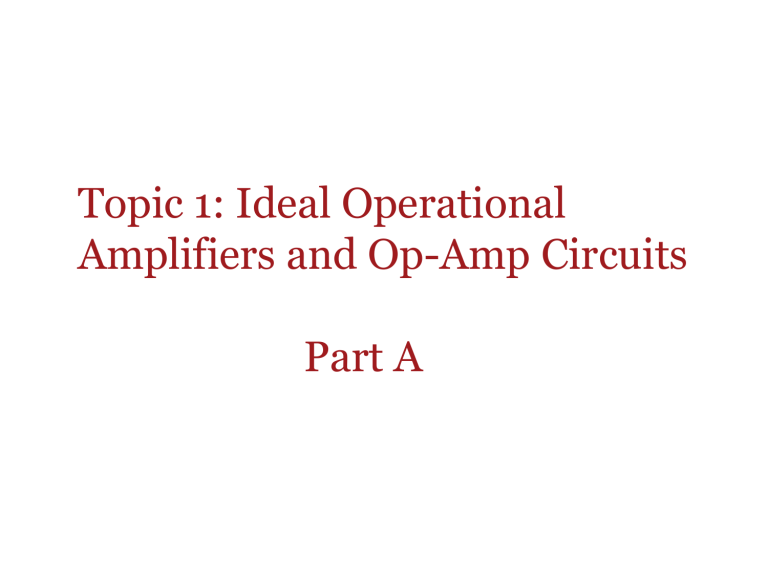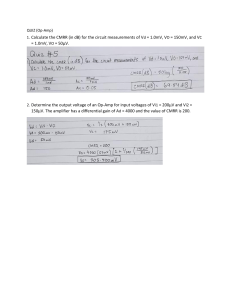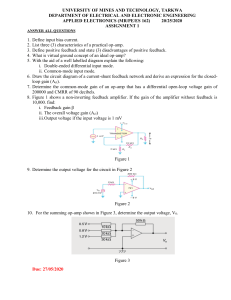
Topic 1: Ideal Operational Amplifiers and Op-Amp Circuits Part A Introduction: Ideal Operational Amplifier Operational amplifier (Op-amp) is made of many transistors, diodes, resistors and capacitors in integrated circuit technology. Ideal op-amp is characterized by: Infinite input impedance Infinite gain for differential input Zero output impedance Infinite frequency bandwidth v0 Aod v1 v2 2 Operational Amplifiers Applications arise in which we wish to connect one circuit to another without the first circuit loading the second. This requires that we connect to a “block” that has infinite input impedance and zero output impedance. An operational amplifier does a good job of approximating this. Consider the following: + Circuit 1 Vin _ The "Block" + Vout Circuit 2 _ Illustrating Isolation. 3 Operational Amplifiers 4 © Dr. ANAS Equivalent Circuit of Op-Amp Saturation +ve output voltage means OpAmp sources current - ve output voltage means OpAmp sinks current 5 Operational Amplifiers A model of the op amp, with respect to the symbol, is shown below. Ro V1 V1 + _ _ Vd + V2 Ro Ri Aodd vd AV Vo Vd Ri AV Aoddvd Vo + V2 _ Working circuit diagram of op amp. Op Amp Model. Aod is the open- loop differential gain If v2 is grounded, and Ri is very large v10, “virtual ground” concept 6 Operational Amplifiers Application: As an application of the previous model, consider the following configuration. resistors R1 and R2. Find Vo as a function of Vin and the R2 R2 R1 + _ Vin vVdi + + Vo _ _ Op amp functional circuit. (inverting amplifier) Av is the closed- loop voltage gain _ b a _ + Vin Ro R1 + Ri A AV odi vd Vo + _ Total op amp schematic for voltage gain 7 configuration. Operational Amplifiers R2 Example Ro R1 + _ Vin vVdi _ b a + Ri Aodi vd AV Vo + R1 = 10 k R2 = 40 k Ro = 50 Aod = 1000,000 Ri = 1 M Calculate Av _ Solution We can write the following equations for nodes a and b. Vin vd vd vd Vo R1 Ri R2 Vin vd v v Vo d d 10k 1000k 40k (1) 8 Operational Amplifiers We can write the following equations for nodes a and b. vd Vo Vo Aod vd R0 R2 vd Vo Vo Aod vd 50 (2) 40k From (1) 25Vo 126vd 100Vin From (2) 4.005 10 Vo 4 10 vd 0 5 Vo 3.99Vin 9 𝑉0 = −3.99 𝑉𝑖𝑛 9 Operational Amplifiers For most all operational amplifiers, Ri is 1 M or larger and Ro is around 50 or less. The open-loop gain, Aod, is greater than 100,000. Ideal Op Amp: The following assumptions are made for the ideal op amp. 1. Infinite open loop gain; Aod 2. Zero output resistance; Ro 0 3. Infinite input resistance; Ri 10 Ideal Op Amp: i1 = 0 + V1 _ i2 = 0 + _ _ vVdi + + V2 = V1 _ + Vo _ Ideal op amp. (a) i1 = i2 = 0: Due to infinite input resistance. (b) vd is negligibly small; V1 = V2. 11 Op-amp are almost always used with a negative feedback: Part of the output signal is returned to the input with negative sign Feedback reduces the gain of op-amp Since op-amp has large gain even small input produces large output, thus for the limited output voltage (lest than VCC) the input voltage vd must be very small. Practically we set vd to zero when analyzing the op-amp circuits. i2 with vd =0 i1 = vin /R1 i2 = i1 and i1 vo = -i2 R2 = -vin R2 /R1 so Av=vo /vin =-R2 /R1 12 © Dr. ANAS Inverting Amplifier Inverting Amplifier (same as last slide) Find Vo in terms of Vin for the following configuration. R2 R1 + Vin Writing a nodal equation at (a) gives; (Vin vd ) vd Vo R1 R2 a _ vVdi + + Vo With vd = 0 we have; V0 _ _ R2 Vin R1 Vin Vin R R The input impedance: in iin Vin 0 1 R1 With R2 = 40 k and R1 = 10 k, we have Vo 4Vin Earlier we got Vo 3.99Vin 13 Inverting Amplifier Example 2: Consider the op amp configuration below. Assume Vin = 5 V At node “a” we can write; 6 k 1 k ( Vin 3 ) 3 V0 1k 6k a + _+ Vin V0 = -51 V _ + 3V V0 (op amp will saturate) _ 14 © Dr. ANAS Solution 𝑣𝑠 15 Simulation R2 2k https://www.multisim. com/content/oKwHW P5i59BmNkEKjePVo g/inverting-opamp/open/ 16 Simulation R2 4k 17 Simulation R2 8k 18 Simulation R2 20k 19 1. If noninverting terminal is grounded, then inverting terminal is virtual ground. a. Sum currents at node assuming no current enters Op Amp. 2. If noninverting terminal is not grounded, then inverting terminal voltage is equal to that of the noninverting terminal. a. Sum currents at node assuming no current enters Op Amp. 3. Output voltage is determined from either Step 1 or 2. © Dr. ANAS Problem-Solving Technique: Ideal Op-Amp Circuits Topic 1: Ideal Operational Amplifiers and Op-Amp Circuits Part B © Dr. ANAS Inverting Op-Amp with T-Network Assume that the amplifier is designed to have Av=-100 and an input resistance is Ri=R1=50kΩ (feedback resistance) R2= 5MΩ which is too large for most practical circuits R3 R3 R2 Av (1 ) R1 R4 R2 It allows us to obtain a large gain with reasonably sized resistors. 22 © Dr. ANAS What is this topology useful for? It allows us to obtain a large gain with reasonably sized resistors. 4 23 Design an Op-Amp with a T-Network assuming the following parameters: VI(max)=12mV (rms), R1=1kΩ, Vo(max)=1.2V (rms), all resistors are less than 500kΩ © Dr. ANAS Example Solution vo 1.2 Av 100 vI 0.012 R3 R3 R2 Av (1 ) R1 R4 R2 R3 Av 5 8 100 R4 R3 212 .5 R4 Assume R2 5 R1 R3 7 R2 R1 1k R2 5k R3 35k R4 2.91 14k kΩ 24 © Dr. ANAS Inverting Op-Amp with Finite Differential-Mode Gain Av R2 R1 1 R2 1 [1 (1 )] Aod R1 25 © Dr. ANAS Inverting Summing Op-Amp Here, we use the superposition theorem and the concept of virtual ground vO ( if R1 R2 R3 RF RF R R vI1 F vI 2 F vI 3 ) R1 R2 R3 vO (vI 1 vI 2 vI 3 ) 26 © Dr. ANAS Example Consider an ideal summing amplifier with R1=20kΩ, R2=40kΩ, R3=50kΩ, and RF=200kΩ. Determine the output voltage for vI1=0.25V, vI2=0.3V, vI3=-0.5V. Solution RF RF RF vO ( vI 1 vI 2 vI 3 ) R1 R2 R3 Input Signals vO (10 0.25 5 0.30 4 0.50) 3V RF 200k V6 15Vdc FREQ = 1k -250.0mV R1 VAMPL = 0.1 VOFF = -0.25 VI1 20k 3 0 107.5uV 0 1 OS1 -15.00V 6 OUT V- UA771 2 - 4 3.002V V11 + 7 U1 OS2 V+ VOUT 5 Output V12 0 FREQ = 1k 300.0mVR2 VI2 VAMPL = 0.1 VOFF = 0.3 15Vdc V7 15.00V 40k 0 0 V13 FREQ = 1k -500.0mVR3 VI3 VAMPL = 0.1 VOFF = -0.5 50k Input Signals 0 27 Noninverting Op-Amp The input signal is applied to the non-inverting terminal; v1=v2 virtual short (but in true short circuit, current flows) (0 v2 ) v2 vo R1 R2 Av v0 R2 1 v2 R1 1) The output signal is in-phase with the input signal 2) The gain is always greater than one if R1 R Av 1 2 1 independent of R2 voltage follower configuration So you can use any value for R2. Let us assume R2 =zero. 28 © Dr. ANAS Voltage Follower The voltage follower is used as a buffer between the source and the load. It prevents the loading effect (attenuation in the signal voltage). vO RL 1 0.01 vI RL RS 1 100 vO vI Too much loading 29 © Dr. ANAS Noninverting Summing Op-Amp 𝑽𝒐𝒖𝒕 𝑹𝒇 + = 𝟏+ 𝑽 𝑹𝒂 𝑽+ 30 25 𝑘Ω Example Find the output 𝑉0 for 𝑉1 = 1 𝑚𝑉, 𝑉2 = 5 𝑚𝑉, 𝑎𝑛𝑑 𝑉3 = 10 𝑚𝑉 5 𝑘Ω 𝑉3 𝑉0 10 𝑘Ω 15 𝑘Ω 31 Example Design a summer that has an output voltage given by vO=1.5vs1-5vs2+0.1vs3 Solution 1: we have, Rf1 R1 vO1 ( 1.5 , Rf1 R1 Rf1 R3 v S1 Rf1 R3 0.1 Let R1 2K , R f 1 3K ,R3 30K vS 3 ) Rf 2 Rf 2 vO vO1 vS 2 R2 R4 Rf 2 R2 5 Rf 2 R4 1 Let R2 2K , R f 2 10K ,R4 10K © Dr. ANAS Current-to-Voltage Converter The output of a photodiode (solar cell) is a current. We can convert this output current to an output voltage. Ri v1 0 i1 In most cases, we assume that RS>>Ri; therefore i1 i2 iS and vO RF i2 RF iS 33 Voltage-to-Current Converter Practical circuit with no terminal grounded 𝑹𝑭 𝑽𝑰 𝒊𝑳 = − 𝑽𝑰 = − 𝑹𝟏 𝑹𝟑 𝑹𝟐 34 Determine a load current in a voltage-to-current converter. Consider the circuit in Figure. Let ZL = 100 , R1 = 10 k, R2 = 1 k, R3 = 1 k, and RF = 10 k. If vI = −5 V, determine the load current iL and the output voltage vO. 35 © Dr. ANAS Op-Amp Difference Amplifier For the amplification of difference of input signals (b) vO1 (c) R2 vI 1 R1 R R4 vI 2 vO 2 1 2 R1 R3 R4 vO vO1 vO 2 (a ) R2 R4 R vI 2 2 vI 1 vO 1 R1 R1 R3 R4 vO 0 for vI 2 vI 1 R4 R2 R3 1 R1 1 R4 R3 R vO 2 vI 2 vI 1 R2 valid for R4 R2 R1 R1 R3 R1 R vO 4 vI 2 vI 1 𝑣𝑜 = 𝐴𝑑 𝑣𝑑 R3 36 Design the difference amplifier with the configuration shown in Figure such that the differential gain is 30. Standard valued resistors are to be used and the maximum resistor value is to be 500 k 37 Example Design a summer that has an output voltage given by vO=1.5vs1-5vs2+0.1vs3 Solution 2: © Dr. ANAS Op-Amp Difference Amplifier Problems: 1. Different input resistances Rin1≠ Rin2. Rin1 R1 Rin 2 R3 R4 2. Small input resistances Rin1 and Rin2. 3. Two resistors must be changed simultaneously in order to alter the gain Remember that R4 R2 R3 R1 Question: What is the Differential Input Resistance? 39 Op-Amp Difference Amplifier input impedance Rinput ix Define input impedance as Rinput vx ix vx ix Using virtual short concept can hence right a loop equation: R R Remember that 4 2 R3 R1 Ex. R4 R2 , R3 R1 The Differential Input Resistance vx ix R1 ix R1 ix 2 R1 Rinput Rinput 2 R1 40 Op-Amp Difference Amplifier input impedance In the ideal difference amplifier, vo=0 for VI1=VI2 . However, for R4 R2 and VI1=VI2 , the input is called Common-mode input signal R3 R1 The Common-mode input voltage is defined as: vcm The Common-mode gain is defined as: Acm vo vcm vI 2 vI 1 2 ideally vo 0 Acm 0 A figure of merit for difference amplifier is the Common-mode rejection ratio (CMRR) which is defined as: CMRR ideally CMRR Ad Acm CMRRdB 20 log10 Ad Acm 41 Op-Amp Difference Amplifier input impedance 𝑽𝒐 = 𝑨𝒅 𝒗𝒅 + 𝑨𝒄𝒎 𝒗𝒄𝒎 𝑣𝑑 = 𝑣𝐼2 − 𝑣𝐼1 𝒗𝑰𝟏 𝒗𝒅 = 𝒗𝒄𝒎 − 𝟐 vcm 𝒗𝑰𝟐 vI 2 vI 1 2 𝒗𝒅 = 𝒗𝒄𝒎 + 𝟐 Ad CMRR Acm CMRRdB 20 log10 Ad Acm Example: Calculate the common-mode rejection ratio of a difference amplifier. Let R2/R1 = 10 and R4/R3 = 11. R R4 R vI 2 2 vI 1 vO 1 2 R1 R1 R3 R4 43 © Dr. ANAS Op-amp Applications 44 © Dr. ANAS Op-amp Applications 45 Op-amp Applications Op-Amp Integrator Av Z2 Z1 for Z1 R1 , and Z 2 or 1 1 vO vI SC2 R1SC2 dv vI C2 O 0 R1 dt t 1 vO t vO (0) v I d R1C2 0 If the input is finite step function, the output will be a linear function of time (ramp function) and will saturate at power supply voltage vI Example Determine the time constant required in an integrator. Consider the integrator shown in Figure. Assume that voltage VC across the capacitor is zero at t = 0. A step input voltage of vI = −1 V is applied at t = 0. Determine the time constant required such that the output reaches +10 V at t = 1 ms. 47 Example If v1 = 10 cos 2 t mV and v2 = 0.5 t mV, find vo in the op amp circuit in Figure. Assume that the voltage across the capacitor is initially zero. 48 Op-amp Applications Op-Amp Differentiator Z Av 2 Z1 for Z1 1 , and Z 2 R2 SC1 vO R2 SC1vI or C1 dvI vO 0 dt R2 vO R2C1 dvI dt Op-amp Applications Log and Antilog Amplifiers Log Amplifier Antilog Amplifier vD vI iD I s exp 1 VT R1 v vO vD VT ln I 1 I s R1 vD vO iD I s exp 1 R1 VT v vI vD vO R1 I s exp I VT 1 Find output voltage if 𝐼𝑠 = 150 𝑛𝐴, 𝑣𝑖 = 2𝑉, 𝑎𝑛𝑑 𝑅1 = 100 𝑘Ω 𝑣𝑜 = −25𝑚𝑉 ln 2 = −0.122 𝑉 150𝑛 × 100𝑘 52 v1 log . Amp. ln v1 Summer v2 log . Amp. ln v2 Amp. ln v1 v2 Antilog Amp. v1 v2 53 Solving a Differential Equation using Op-amp 𝑑 2 𝑉𝑜 𝑑𝑉𝑜 + 𝑃 + 𝑄𝑉𝑜 = 𝑉𝑖 𝑑𝑡 2 𝑑𝑡 54 55 56 57



